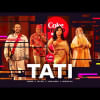Baaji: The cost of Indigenous representation in Coke Studio Bangla

I pressed play on Coke Studio Bangla's latest release, Baaji. The first notes of Marma music filled me with pride. Here was a piece of my heritage on a prominent stage! But as the video unravelled, a familiar unease set in.
Written by Bangalee artist Hashim Mahmud, Baaji tells a love story. It follows a man journeying into the hills and the sea, seemingly in pursuit of an Indigenous woman, singing "I know I can get you! I bet you!" Even if playful, this line echoes a troubling trope often sold in the tourism industry: go to the hills, find the elusive pahari meye. The storyline casts her as so mysterious that even her tears are questioned: "Are they a trick, a tease, or true?" Or does this framing teach us that Indigenous women's pain is performance, and they send mixed signals?
Even more surprising, though the song romanticises an Indigenous woman, the video casts a Bangalee theatre artist. Listening with your eyes closed, you may imagine an Indigenous woman; open them and you see a masterclass of erasure!
Could this not have been an exception to the recurring trope in Bangladeshi storytelling where the man seeks and the woman is the reward? I'm not asking for a simple gender reversal, but for a rethinking of the patriarchal framework where one gender acts and the other remains static. This trope becomes far more troubling when applied to Indigenous women, who already navigate a brutal reality often shaped by fetishisation, violence, and erasure.
In May 2025, the body of a 29-year-old Khyang woman was found in a ditch near the under-construction Thanchi-Likri border road. Locals and Indigenous activists claim she was gang-raped and murdered. A 2022 International Work Group for Indigenous Affairs (IWGIA) report shows that around 43 percent of gender-based violence cases involving Indigenous women occurred in the plains. In 2018, Amnesty International called for investigation into the rape of two Marma sisters. These are not isolated incidents, but part of a systemic pattern shaped largely by the male gaze.
Indigenous scholar Chandra K Roy notes how dominant narratives often exoticise Indigenous women while silencing them. Feminist scholar Anne McClintock describes this as the "colonial fantasy", reducing women to passive, hyper-sexualised figures. Professor Jasbir Puar, an American academic and author, argues that racialised desire becomes a form of symbolic conquest, sustaining structures of domination.
This is the context in which Baaji lands.
Yes, music invites multiple readings. While some see just a love story, I see this through the lens of an Indigenous woman living with these patterns. Both views matter. However, Coke Studio isn't fringe. It is a global, corporately-funded platform. In Bangladesh, where many know little about Indigenous struggles, its visuals, lyrics, and casting have the power to shape how millions see us. And when such a platform enters stories rooted in colonisation and gendered violence, it cannot separate the storytelling from the history it carries.
But how is it that all our advocacy around the erasure and exploitation of Indigenous women does not register in the national conscience? Are people unaware, or do they just not care? Over time, I've realised that the burden of understanding is not mine. It rests with the powers that be.
I checked the credits, hoping for Indigenous representation beyond one vocalist, a flute player, and a "bamboo dance" team. None held decision-making roles. Baaji boasts elite musicians, directors, and corporate marketers. So is it a systemic exclusion or just an oversight?
The "bamboo dance" has become a convenient media shorthand to signal "Indigenous culture." The video features a Marma elder singing, an oral tradition my grandmother also carried. But the origin of the melody goes unexplained. These details matter. They make the difference between respectful homage and cultural reduction.
Contrast this with how some other artists approach cross-cultural collaboration. In Sapphire, Arijit Singh and Ed Sheeran embraced Indian culture with depth. Indian instruments like the tabla and sitar weren't used as exotic sound effects but integrated into the core composition. Sheeran does not lead the story. He's a respectful guest walking alongside Arijit and local artists.
Or take Sunehra Tasnim, a Bangladeshi content creator, who recently released a video about Rangamati. She didn't romanticise Kaptai Lake. She acknowledged its violent history and the displacement of Indigenous communities. She wore a traditional Chakma pinon hadi, explained its meaning, highlighted an Indigenous artisan and shared the spotlight with Indigenous creator Tiya Chakma. She even spoke Chakma to express a desire for connection.
So, can an Indigenous woman and a Bangalee man not fall in love? Of course, they can. But love doesn't float in a vacuum, especially when Indigenous women are often silenced, displaced, and disappeared. Hence, when a powerful platform tells a story of a Bangalee man searching for an Indigenous woman who doesn't speak, sing, or choose, is that really romance?
I name Bangalee cultural workers not out of malice, but to ask the dominant group holding the capital in Bangladesh to tell stories with accountability. Politics exists whether the video acknowledges it or not. If your story unfolds on colonised space, features Indigenous bodies, and borrows cultural symbols, it's already political. From Lalon's spiritual songs to Bob Dylan's protest anthems, music has the power to speak the truth. So why should Coke Studio borrowpolitical aesthetics without any responsibility for how it represents them?
Then how do we know if a collaboration is meaningful? Ask the represented community: Do you feel seen? For me, the answer is no. Despite the production value, it lacked the depth that makes a cultural exchange authentic. What could they have done differently? Collaborated with Indigenous artists and historians as co-creators, researched social and historical contexts, and challenged imagery tying land and femininity to silence.
As a marginalised community, we're often made to feel grateful for scraps of visibility. Yes, being featured matters. It sparks curiosity and recognises us as part of this land's cultural fabric. But gratitude doesn't erase the need for critique. And this critique doesn't come from bitterness. It comes from love—for our truth and the Indigenous women being objectified for generations.
If similar portrayals featured Palestinian women in Gaza, Kuki women in Northeast India, Yazidi women in Iraq and Syria, or First Nations women in Australia and New Zealand, the harm would be equally serious.
Representation without inclusion is tokenism. With systemic exclusion, it perpetuates structural violence. I am asking platforms like Coke Studio not to tell our stories without us because #RealMagic happens through research, respect, and responsibility.
Myat Moe Khaing is a graduate student of social work in Australia. She can be reached at [email protected].
Views expressed in this article are the author's own.
Follow The Daily Star Opinion on Facebook for the latest opinions, commentaries and analyses by experts and professionals. To contribute your article or letter to The Daily Star Opinion, see our guidelines for submission.

 For all latest news, follow The Daily Star's Google News channel.
For all latest news, follow The Daily Star's Google News channel. 










Comments